Robert Moreland never planned on being an artist. Born in the Deep South in Baton Rouge, Louisiana, there were few, if any, examples for Moreland to follow down a path that led to a fine art practice. There were moments of deeper artistic understanding that came from time spent alongside his mother in her art conservation studio, a couple stints in craft school classes that opened his eyes to the tangible, builderly side of creating, and several years of quietly making his own assemblage works and paintings in his garage. But it wasn’t until his move to Los Angeles almost six years ago that Moreland really came into his own creatively. For Moreland, Los Angeles presented a new beginning. It was a city where no one knew him, and where he could immerse himself into the unfamiliar art scenes and characters that inhabited them. It was thrilling and shocking at the same time, and ultimately was the impetus for the work he’s become known for over the last handful of years.
Moreland’s multi-paneled and largely monochromatic sculptures—or should we call them paintings? It’s a distinction that the artist himself doesn’t want to make—focus on the experiential act of viewing art rather than the transmission of conceptual information. His works, made primarily of wood, paint, and a canvas-like material, all held together by clean metal tacks and hearty leather straps, maintains a persistent focus on the dynamic relationships between shape, form, and color. His crisp nonrepresentational works intend for the viewer to experience his artwork with instinctive, physical responses to the work’s structure, intense color, and surrounding space rather than with interpretive examination. Moreland encourages a silent encounter with the artwork by presenting bold and contrasting colors, free of gestural brushstrokes or recognizable imagery. Panels protrude gracefully from the wall, allowing each piece to inhabit the space as confidently as the viewer before them. I spent a lovely morning with Moreland in his studio on the outskirts of Los Angeles’ Chinatown, where we talked about his upbringing, his practice, and his ultimate willingness to drop traditional painting’s insistence on the rectangular frame to present a new way of observing and experiencing artwork.

What have you been up to recently?
Things have been going pretty well. What I’ve been up to is staying in this room for twelve hours a day. It’s probably time to start training some people, but I’m also a little hesitant because I originally got into this so I could be alone and kind of space out and do my thing. But it’s starting to turn into something more than that, so I’m looking around. I’ve got a couple of guys I’ve been talking to bring into the studio with me
I feel like that might be a weird point to get to—spending countless hours a day in the studio and reflecting on the reason why you started making art, which for you was to be alone, and now having to bring people into your space and interact with others besides yourself.
The fact that you don’t notice it, is the weird thing. I’m fortunate that things are going well and I’ve gotten people interested in the work. It is strange, it almost feels like I’m not really experiencing it because I think that’s how we all feel. Sometimes we wonder what it looks like from the outside. I need a bigger space. I love this space.
I mean your pieces are so big.
Yeah. did you see the hallway when you were walking in? I’m lucky they let me stash them out there. Jen Stark and I were the first ones that moved into this space when it opened. There weren’t even walls up. It was just a bunch of old Chinese boxes with Chinatown trinkets piled to the ceiling. It was quite amazing.
Now the Shepard Fairey’s of the world are renting out almost half of this building and shutting down the street for retrospective shows.
Yeah, it’s crazy. I was here one night working, and I just left my door open and Roger Waters walked in from Pink Floyd. He was just looking around and I had thought the building was pretty much empty aside from the main space. I just kind of froze and stared into his eyes.
Did he come in at all?
He came in and just said, “Oh hi, just looking around.” No big deal. I was doing something. You know, painting—I call these pieces paintings, I also call them sculptures, but I don’t know if I’m a real painter or not. I think I’m more of a builder than a painter.
That makes sense from what I’ve seen of your work. I feel like they’re almost a combo of both painting and sculpture.
I suppose it’s a combo, I’m not trying to nail it down really.
Seeing these pieces up close, I didn’t even know that you used different materials. I thought it was just all paint on wood.
Yeah, it’s hard to tell when you see them in photos or digitally.

Instagram doesn’t do anything justice.
No, it’s unfortunate. I’m always hesitant to post the backs of the pieces, but as you can see, I don’t use staples. It’s all hand-stretched backs. I go through pains to make sure it’s as tight as possible. I probably should show some details, but I also don’t want everyone in the world seeing—you know how Instagram is now.
Everyone’s got an opinion.
I’ve gotta say, Instagram has been pretty vital in all of this happening. Because, honestly, no one was looking. I didn’t have much of a resume to speak of, just some Southern stuff. I didn’t go to school so I wasn’t plugged in and Instagram just puts it out there in front of everyone. I love it but you know how Instagram can get a little icky. I’m wondering what it’s doing to our minds, all the nonstop information.
Yes, the constant scroll.
It has to be doing something. I can’t get rid of it though, it’s too important right now. It’s true, literally… I mean Anthony at Wilding Cran, he and I met the organic old-fashioned way just walking around town, a friend introduced us.
Is that what you devoted most of your time to over the summer?
Yeah, I did a big wooden sculpture and about ten wall pieces. I usually make small paper maquettes first, but what happened with this show is that over the six months leading up to it I didn’t have much time to stop and contemplate much. I’ve been on go mode. I think I need to go away for a month or two, but also my representing gallery—G Gallery in Korea—sold all of my work and I like to keep them with work. They’ve got a few fairs that they’re going to put me in. My friend Cleon Peterson’s work went to Over The Influence gallery and they’re doing a fair in Shanghai in November, and they asked him who he wanted to show with and he asked if I could do it.
What an awesome opportunity.
Yeah, it’s awesome. Cleon’s work is fantastic and it’s a really nice contrast to mine. They’ve been great, they’ve been super on it. I’m doing just black and white works for Over The Influence.
You seem very busy.
It’s fantastic! This is what I’ve wanted my whole life, you know? But growing up, as I said, I didn’t go to school and in the South, there’s a certain idea of what art is. My mother is an art conservator, so I grew up in her studio mostly looking at older works and things like that. That was my idea of what art was. Then, my friends were going to LSU, I had dropped out of high school, got my GED, but I fell in with this art group in Baton Rouge and we all lived together. They were all going to school, and I was just making things, not really knowing anything about anything. I would go to campus and mess around in the studios. I got to meet a lot of professors and became friends with them. They would let me come to the studios and make work at night and sit in on lectures. That’s where I get most of my art supplies. At the end of the semester, all the art students that were taking the class as an elective, threw all of their supplies away so I would raid the art school dumpsters.
So art has kind of been a part of your life since the beginning?
My mother painted a little bit when she was in her twenties. She’s more of a scientist. I ended up working for her for several years. Art conservation is such tedious work, but I think it taught me a lot about taking your time and the difference one small move done over and over, multiplied by thousands, it can create something really nice. It taught me to slow down and, I think in some ways, that’s how I’m able to stretch these pieces using tacks even though it takes a long time. I really enjoy it, I just space out. Honestly, with the complete lack of control that all of us seem to have these days, I can come in here and be as controlling as I like.
I recently edited an interview with an artist for our newest issue of the magazine and he was talking about how he loves the building process of his canvases because there’s no creative thought with it. It’s like, “Here’s the task at hand, I’m getting it done.” It is part of the whole painting process and his process as a whole, but it’s very much mindless but also soothing.
It’s fantastic. I mean really, once I design the maquettes, building the large ones is just step by step. I know what I have to do when I wake up, which is a nice feeling. I spent many years not knowing what it was I was supposed to do every day aside from going to some crappy job or something. It’s a really unsettling feeling to not know. Too much to think about.
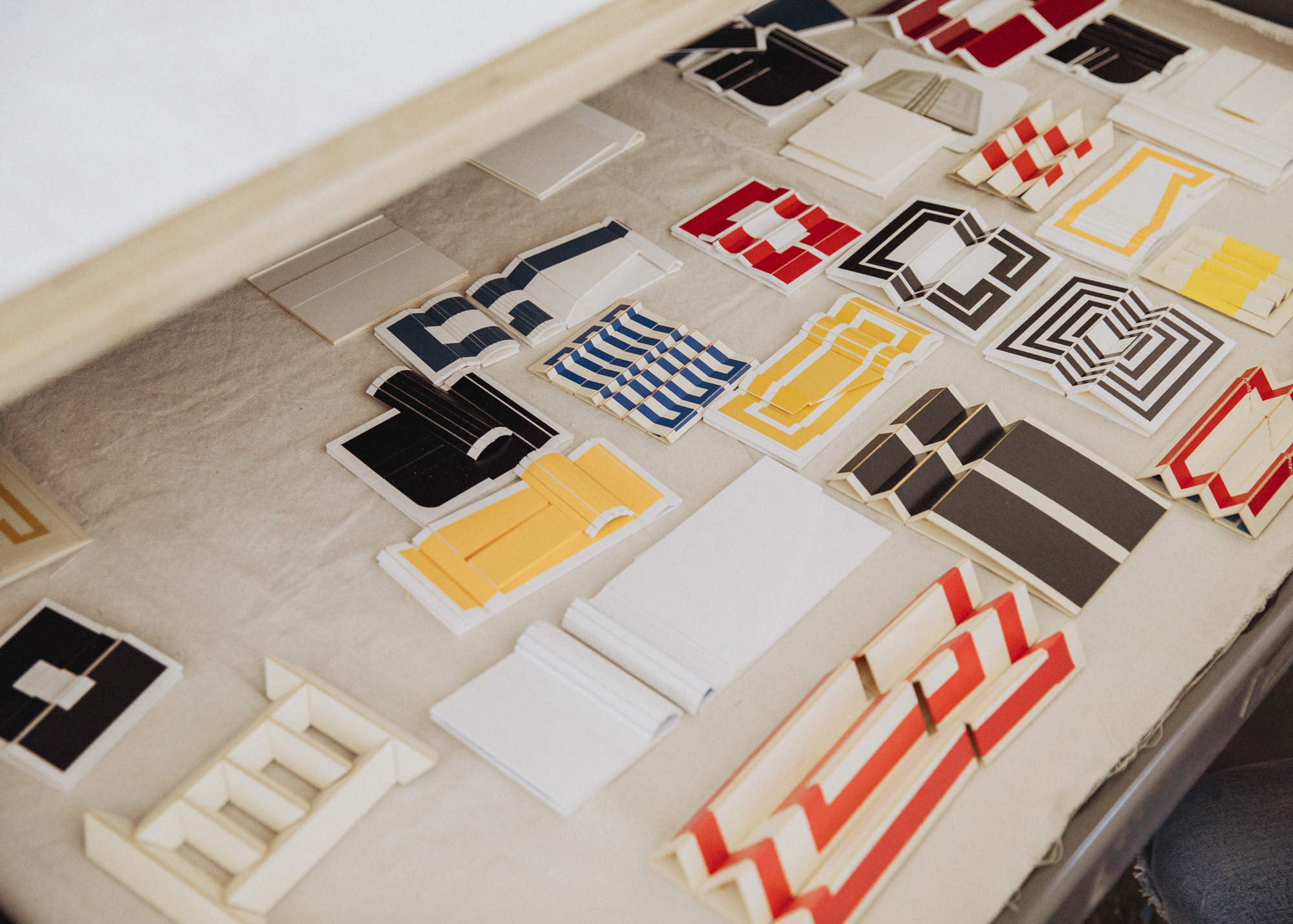
The process really starts with the maquettes then?
It’s gotten to the point where I don’t have to do them so much anymore. I want to because I usually stumble upon new designs and new ideas through the process, but I’ve gotten pretty good at visualizing what I want to do. I also never make a duplicate piece, but I will do iterations of an idea to stretch that specific concept out as far as I can and really try to get as much from each idea as possible.
I want to go back before we jump into like focusing on just the work itself. When did you drop out of high school?
Tenth grade.
At that point were you thinking you were going to be an artist?
No, at that point I was like, “I’m going to do a lot of drugs and hang out.” I was skateboarding and I had gotten into rock climbing which is hilarious in the deep South. But we built this fantastic rock gym and we would travel up north on trips and go climbing. I was working at different restaurants, washing dishes, then I became the fry cook at some Louisiana-style restaurant. I worked at a fried chicken shack for a long time and lived off of that food for a while. All the free chicken you can eat. I was drawing and messing around with clay but I wasn’t thinking it was anything. I didn’t know what I was doing.
You were winging it.
Then I got a job working for a guy who made fine wood furniture. He taught me basically everything I know about the material. I knew how to use a tape measure in some sense, but I went in and I was like, “Look, I don’t really know what you’re talking about when you tell me a dimension. Don’t throw me in making exact cuts right now.” So I worked for him for about five years and we made some really nice stuff. I figured out how to use tools and get dirty and I realized how much I enjoyed it. After that, I worked for a stained glass artist, which was another really technical job, did five years for him. He was really talented. There’s a lot of really bad stained glass out of there, it’s a pretty limited medium.
At some point, all my friends started graduating college and the writing was on the wall, that I didn’t have a degree. I started getting a little worried and really started making work. I was printmaking and putting assemblage pieces together, very Rauschenberg-y. I would just go around to junkyards and find stuff. It was fun, but at some point, I realized I was making nice aesthetic objects with already nice aesthetic objects, you know? That bothered me a little bit because I wasn’t really fully making something. I was completely ignorant about everything. Then I started working with my mother, which had its drawbacks but she was great and taught me a lot. I kept making work and eventually, a friend told me about this place called Penland School of Craft, near Black Mountain in North Carolina. I got a couple of work-study scholarships to go there.
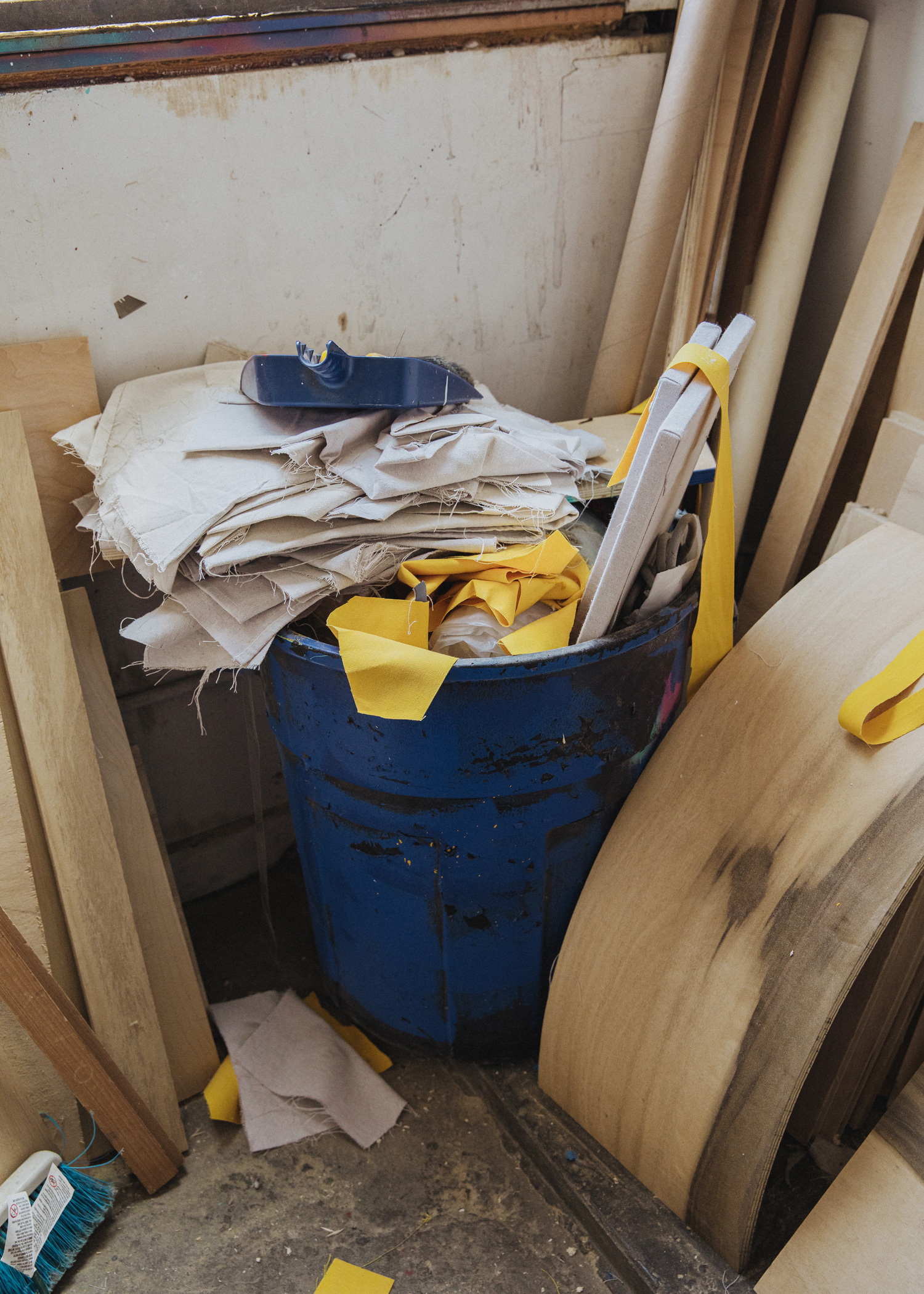
What did you focus on while you were there?
I took a chainsaw wood-sculpting class, which was fun. I immediately bought a big chainsaw afterward and just started making weird sculptures.
You’re like, “Alas, I have found my path a chainsaw sculptor.” Haha
Most chainsaw sculptors are making alligators and bears and stuff like that. I was trying to make abstract, very squared-off sculptures. Nothing to write home about. I took a metalsmithing class too, which was cool. When I got there I realized I was taking it a lot more seriously than the other people. I’d read all the books they told us to read when no one else had. I didn’t want to waste my opportunity there. When I went back to Baton Rouge where people aren’t talking about art all the time—it’s a football city— I was like, “Well, now I really don’t care what any of these people think, I’m just going to do my thing.” So then I started making art all the time. I accidentally sold a piece; I dropped a piece off with a friend who was a photographer but he also owned an art gallery. He came into my work one day at the stained glass shop and handed me a check for $250. At the time I was like, “Oh my god,” my mind was blown.
I kept making work, started getting shows and was still working in the art conservation job with my mom. I think the idea was that I was going to take it over. I’m the youngest of four and I was the only one that was messing with it.
Your mom owned the business?
Yeah, but it was a grind. People would bring in paintings and I was just cleaning them and restretching them. I wanted to make my own work, and people would bring in this work that I thought was garbage. They’re like, “I just made $25,000 for this,” and I was like, “I’m in the wrong game.” I knew I could probably take it over and then I’d just keep my mother’s clients, but that wasn’t for me.
How do you think those years working with your mom were formative?
The main thing was learning to slow down and take my time. We would get these paintings that would have blemishes on them, a portrait from 1880 or something, covered in little fly specks, thousands of them. They all had to be removed individually, and I can remember in the beginning I was complaining, thinking the process was insane. My mom would advise me to just do one at a time. It was amazing how much progress you could make in three or four hours. It’s something that has translated into my process. Each of these pieces has a thousand or more tacks in them. They’re tacks that no one really sees, but I feel like somehow it comes through in the work anyway. I was painting in New Orleans for many years and would use staples, but they look cheap.
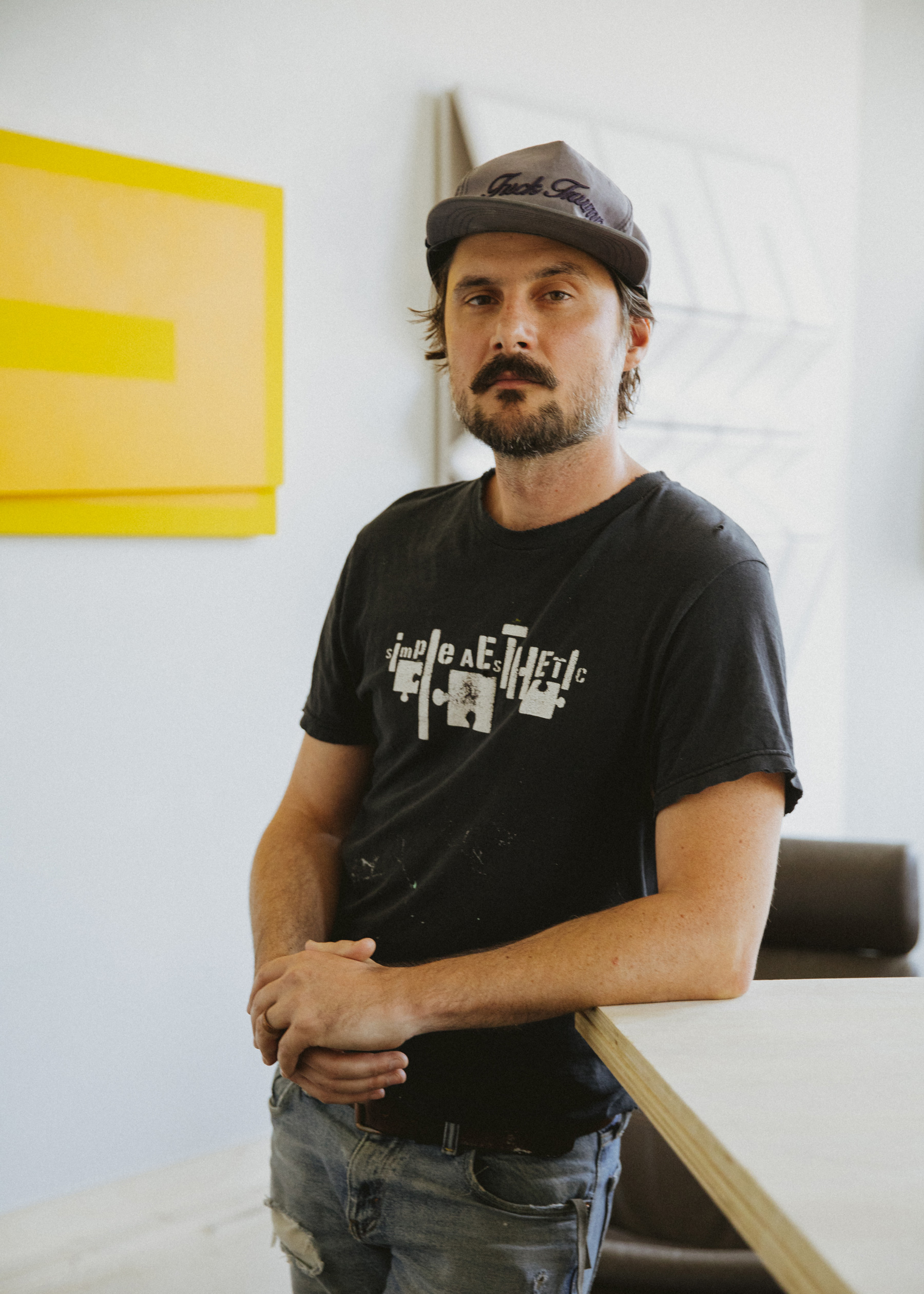
So the work that you were making in New Orleans was mostly paintings?
It was a bit of a transition into this. I was enamored with the post-war abstract expressionists and the Rauschenberg’s and the Twombly’s. I would read all of their biographies. That’s kind of the art world that I saw in my mind down there, the macho painter De Kooning kind of thing. I was also making these abstract paintings. I would use elements of encaustic and then found object stuff and I’d put this stuff together like assemblage work with many different elements. I was trying to have an action painting element to it as well, but for me, action painting is me sitting in front of a canvas, visualizing the exact brush stroke that I want, practicing it on some other trash canvas, and then executing it. That is not action painting, that’s me being a total fraud as an artist. I realized that I have to have way more control than necessary to be an action painter where you’re supposed to just lose complete control.
You weren’t losing any control.
No, no I was just losing my mind. Once we decided to move out here, just because it was greener pastures for Robyn and I both, I started going to museums and galleries. There’s a whole art world in LA that the rest of the country and world don’t know about. I mean I feel like it’s bleeding into New York and Europe a little bit. So I just got blasted with all of this cool information. I stopped making work for a while and soaked it all in. I’d go around trying to meet people. I’d try to walk into galleries and talk to people. I think everybody in this business has to look like an asshole a few times. It’s made to make you feel and look like an asshole. I don’t have much shame about that.
What was your first impression of Los Angeles when you got here?
It wasn’t what I thought it was going to be. I liked how open it was. I’d gone to New York and experienced that. I love New York but it stresses me out. After four days I gotta roll. When I got to LA, I felt completely anonymous. In New Orleans, while I loved it, I’d still see the same people all the time. There’s no anonymity. Here no one gives a shit who I am. It’s fantastic. So that was great, and just the different terrain. I loved it immediately. What makes Los Angeles so different than Louisiana and New Orleans is there’s opportunity everywhere. You can wake up every day and know that you can leave the house and something could happen. There are many different LAs obviously, everyone has a different experience. People can have a really bad experience. Luckily, we landed in Mount Washington. We had some family there, it wasn’t supposed to go down that way. I had a job lined up. As soon as I got here the offer was retracted so—.
I eventually got a job at an art handling company downtown, which showed me behind the art world curtain a little bit. I got to be around actual wealth and art world people. The wealth out here is insane. It took a little adjusting. I thought people on St. Charles Avenue in New Orleans were wealthy, and then all of a sudden I’m standing in a ninety-million dollar house here.
Yeah, it’s crazy.
It was shocking. But also exciting at the same time, which goes back to that whole opportunity thing right? It’s here, you know. Try to stay positive and pay your bills however you can. Work hard and it seems like it works out.
Let’s get into the work. Let’s talk about materials. You said earlier, you’re a builder.
Through the art handling job I ended up meeting a dealer—I met all of the shady flipper dealers, of which there are many. One of them was kind of grooming me to make money off of me—put me into the whole pump ‘em and dump ‘em scheme. Luckily none of that worked out, but he did inspire me to try new things. He’s the one that pointed out, “You build your own canvases, you build all your own stuff, I don’t know anyone who does that. That’s your strong suit. Go make ten pieces that are completely different from anything you’re doing, send them to me, and I’ll tell you what I think.” I made ten pieces and he was like, “No.” I made ten more, and I’ve never needed someone to tell me “good” or “bad,” but he was pushing me to try new things and I really liked that. Eventually, I arrived at an even simpler version of these wall works.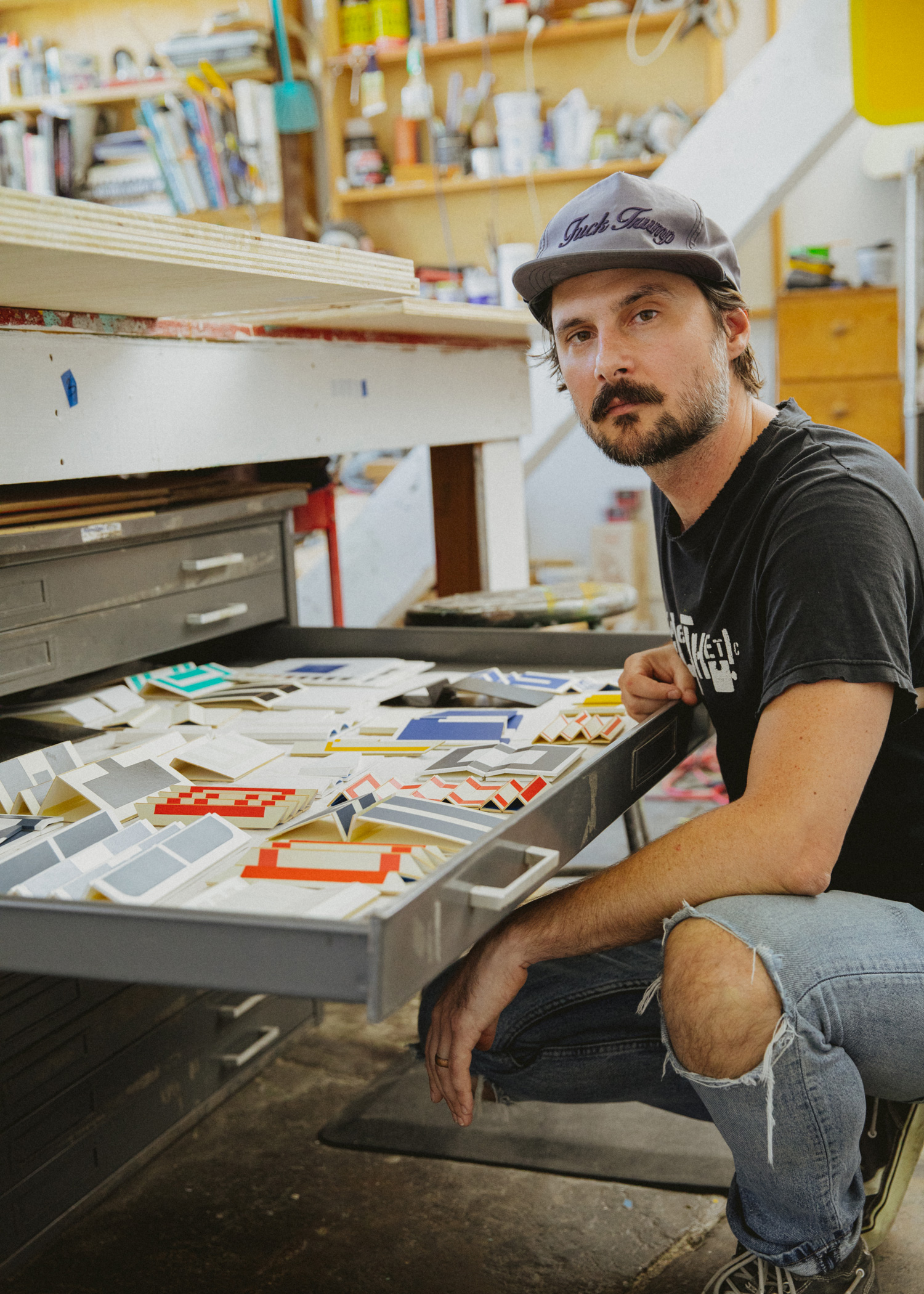
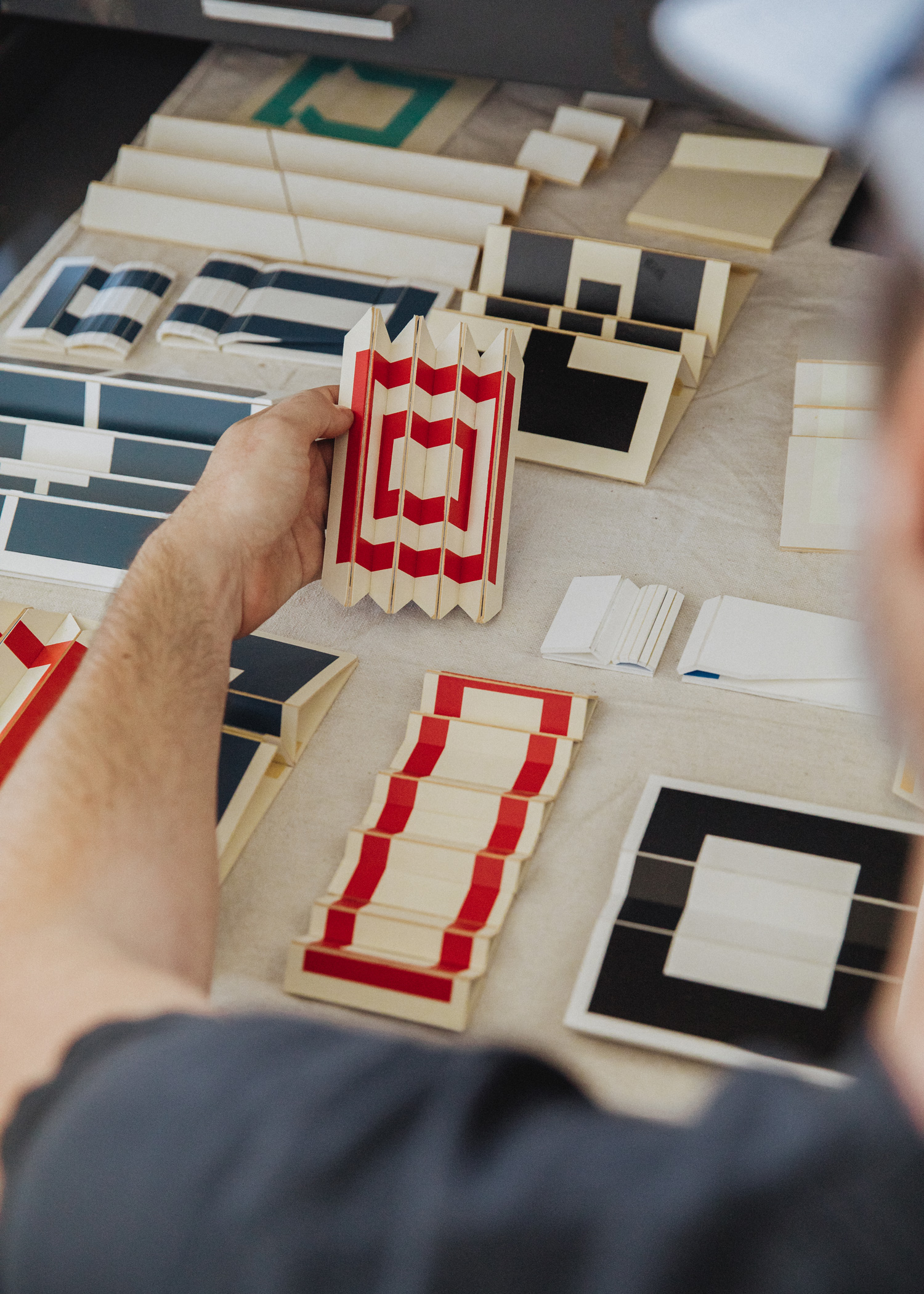
Tell me about those.
I can actually show you. This was one of the first maquettes made out of some sort of filing cabinet paper folders. I made a larger piece of the maquette and something about it felt right. The combination of the raw canvas, tacks, wood, and paint. It’s the perfect combination. There’s nothing superfluous about it. I sent it to him and I felt really good about it, and he was like “Why don’t you fill in the sides? Why don’t you make them out of metal?” I was like, “You know, there are enough metal sculptures out there. Nothing against them but I’m not trying to do that.” He said no and I said goodbye. He just evaporated.
It’s so funny that he was kind of the catalyst to get you to start thinking this way.
I’ve even called him a few times to see if he’d want to go to lunch, he doesn’t return my calls. I don’t know what happened. Well, I guess I do. I wonder how he’s feeling about it now. So yeah, the materials—the curved elements, I didn’t introduce those until a couple of years ago actually. Everything was hard right angles. What you’ll notice with the work is the linework never goes against the shape or the composition, because I want it all to make sense. It needs to be intuitive, so when you see it, you are immediately at ease because it’s the way it’s supposed to be. The linework goes with the facets and points out angles rather than fighting with them. I’ve made two pieces where I had the linework go against the shape, and they’re just totally wrong. They kind of make you feel uneasy.
How do you even curve the wood?
It’s a pretty in-depth process. I don’t do it anymore. I used to when I was working for the woodshop. A friend of mine, Lucky Remington, who makes sculptures and paintings, and has been on the scene for a while, found this warehouse in Anaheim full of curved wood. I feel like the curves bring an organic element to the pieces. There’s something about the curves going against the hard angles, it feels nice. Then with some of these other pieces, I’m trying to create curves with rigid boards. That’s something I’d like to explore more. 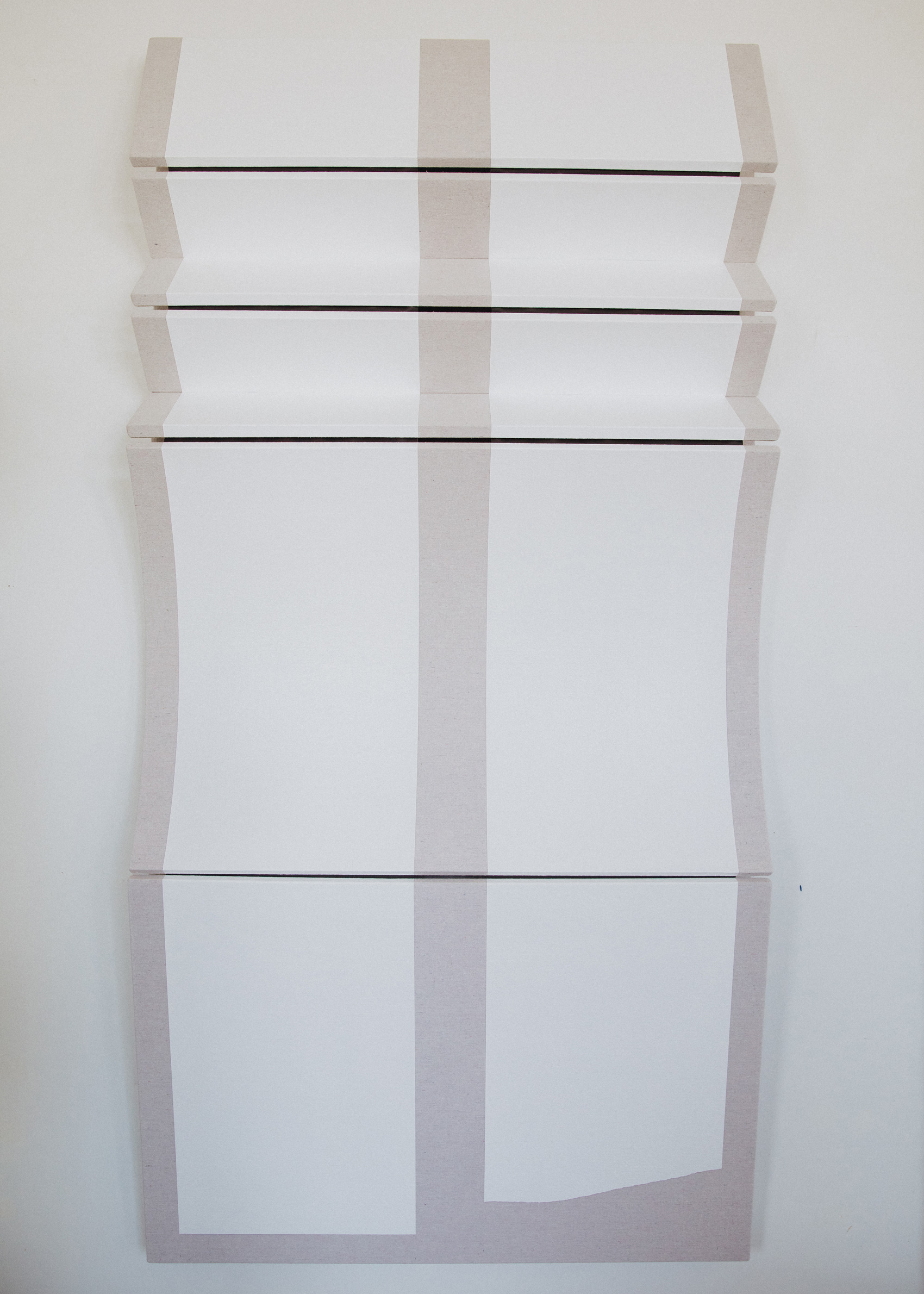
I love that. It reminds me of those wood toys that kind of fold into each other back and forth.
Originally the idea was based on a tank tread or a conveyor belt. I wanted them to be able to manipulate, change, and move them around. I didn’t want it to look static. I wanted it to look like it had some movement to it. Then I found problems with the spacing between each piece—how much space I need for the leather hinges to actually make them be able to move. What I found was they still convey a sense of movement in them. They’re completely static but they may not look that way.
Colors. Are you speaking through them?
When I first started making the work I only worked with primary colors. I wanted them to be as basic as possible. That’s part of the idea behind these, just the simplicity of it all. I wasn’t interested in the crazy colors in the beginning. I still keep it pretty simple. There’s a green that I use now that’s become pretty popular. It’s kind of like that deco green? I call it asylum green because it looks like the tiles of an insane asylum. They’re as simple as I can make them. I can’t make them any simpler. But it’s also an idea that I can just expand upon.
It’s crazy because they’re so stripped down, and I know that’s the goal, but like you said you have the ability to make many variations.
I feel pretty fortunate that I stumbled across this. I’m certainly inspired by the minimalists, I love that. I love Ellsworth Kelly, Donald Judd. I always liked the idea of work being more than just a flat plain. Even when I was young, I remember thinking if I made work, I would make it a little more active. 
You mentioned movement. Is that something you’re trying to portray with these? The illusion of movement?
Yeah, I think it’s the possibility of movement, you know? They’re dynamic in that sense. You’re waiting for them, you can see the movement. It’s in there, it’s just locked and static at the moment. I don’t think I consciously think about movement too much. There isn’t a ton of concept behind them. There is you know, what’s brought me here and the process that I can speak to, but I just want works that are the center of the room, that ground the whole vibe and make people feel a little more at ease. Or at least that’s what I’d want to be around.
These make me at ease because it’s not too much to look at. Easy on the eyes and the mind.
Let’s all just take a breath and relax. I think we could use that. The show at Wilding Cran, I almost titled it “Uncontrollable Screaming” because that’s just how it felt. I thought it was a nice total opposite of what I’m doing here. I ended up going with “Deliberation” which seems to make sense to me. Takes care of the whole process in a single word.
For more from Robert Moreland, follow him on Instagram.
